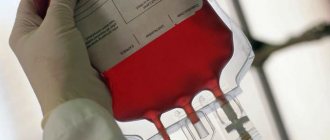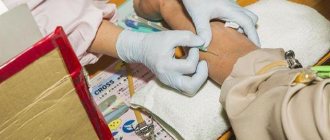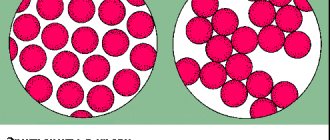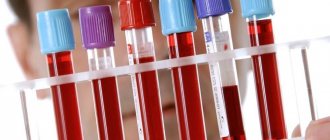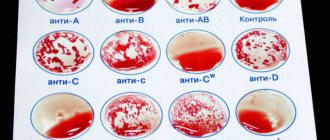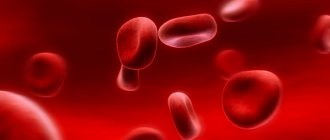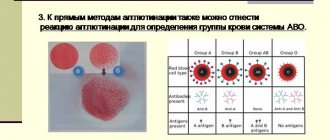There are many classifications that divide blood into groups. All are designed to target different antigens and antibodies—small particles that are either attached to the red blood cell membrane or float freely in the plasma.
The first experiments with blood transfusion most often ended in the death of the patient. The thing is that then people did not have the slightest idea about blood groups. Today, the most common classifications are the AB0 system and the Rh factor system.
According to the ABO system, blood is classified as follows:
- 0 – first,
- A - second,
- B - third,
- AB is the fourth.
Types of blood
What blood groups does a person have, how many groups are there, and the very concept of them is under the jurisdiction of the International Society of Blood Transfusion. This organization has the most complete information on all these issues. For example, the types of blood here are divided into 33 classifications, and this is not the limit.
12 facts about blood: Tsuzmer A.M., Petrishina O.L. Biology. Man and his health. Textbook. 26th ed. - M.: Education, 2001. - 240 p.
The Karl Landsteiner blood groups remain the most widely used today. At the beginning of the twentieth century, a scientist experimented by mixing blood from different donors. In some cases it folded, in others it did not. Based on the data obtained, the following blood group designation was obtained:
- 0 blood group (I);
- blood group A (II);
- B (III);
- AB (IV).
Blood groups: General surgery: textbook / Petrov S.V.
— 3rd ed., revised. and additional - 2010. - 768 p. How are blood types different? Based on practical experience, I will explain in simple words: different groups of red blood cells contain different substances on the surface. If they are not there, then the result is blood type 0. Blood type A2 is endowed with only one type, etc. The main thing that affects the blood type with this approach is the impossibility of mixing them in any combination, says WebMD. And this is a very important parameter. To find out what your blood type is, contact your healthcare provider for professional advice.
The characteristics of blood groups vary among different peoples and populations, the article says. For example, the first and second blood groups are the most common. This is due to the fact that human blood groups are inherited. It’s not for nothing that there are a lot of queries on the Internet about what blood type the Chinese have, what blood type the Jews have, or the blood type in Japan. These numbers do vary.
Interestingly, scientists even tried to find out what Christ’s blood type was. Analyzes were carried out on samples from the Shroud of Turin and determined that Jesus’ blood type was AB (IV).
Thus, blood type is an individual characteristic of each person. Having figured out how the blood type is designated, we will find out what is hidden behind the designations “second positive”, “3 positive”, etc.
LiveInternetLiveInternet
Blood type is your serial number Our past, present and future depend on our blood type! Each blood type has a special characteristic... Our past, present and future depend on our blood type! Each blood group has a special type of immunity peculiar to it, which determines the vital resources of a person laid down by nature. By determining our blood type, we can use our potential given to us from birth. Blood type is the path measured out for us by fate, the main condition of which is to follow the given trajectory. By harmonizing your capabilities and boundaries, you can literally influence the formation of a prosperous destiny. There are four blood groups, with differing biochemical characteristics. This fact was established by science at the beginning of the twentieth century. Throughout the world, four blood groups are designated by symbols: I(0), II(A), III(B), IV(AB). Blood type 0(I) is the most common on the planet - it flows in the veins of 45% of humanity. The first blood group I(0) is the oldest. She is called the first because she was the first to appear on earth. It is not for nothing that those with the first blood group are the bearers of leadership qualities and are endowed with excellent health and irrepressible energy. A(II) blood type predominates among Europeans - approximately 35% of people are its carriers. New living conditions led to a genetic mutation of the blood - a person appeared with new character traits, a person with blood group II (A) B (III) blood group is less numerous - it can be found in only 13% of us. A new blood mutation gave birth to people with a new III (B) blood group, whose immune system accepted exactly this way of life. AB(IV) blood type is the rarest on Earth, found in only 7% of people. At the turn of the new era, during the campaigns of conquest, a mixing of peoples and a merging of blood occurred, which led to the appearance of a person with IV (AB) blood group. The difference between one group and another is determined by the characteristics of blood proteins. Several systems have been created to classify these fairly numerous proteins. The most famous of them is the AB0 system (read - a, 6, zero), in which four groups are distinguished - I, II, III, IV. Group I is called zero and is designated 00, which indicates the presence of two identical genes that determine the group trait - one zero received from the father, the other from the mother. If a child is diagnosed with blood group I, this means that both the father and mother necessarily have gene 0, but this does not mean at all that they also have group I, since their second genes could be different. The group II gene is designated by the letter A. And if a child receives such a gene from both parents, then he, of course, will have blood group II (AA). But he will have the same group even if he receives gene 0 from one of his parents, and A from the other, since gene 0 has one feature - it cannot manifest itself in the presence of gene A. The blood group III gene is designated by the letter B This group is also formed in those who received from their parents two identical BB genes or two different ones - B and 0, because in this combination gene 0 does not manifest itself. What will happen if a child inherits gene A from one of the parents, and gene B from the other? They are tolerant of each other, one does not suppress the other, and their combination leads to the appearance of a new trait - blood group IV (AB). Choosing a partner based on blood type Japanese scientist Masahito Naomi, in the book “You are what your blood type is,” argues that blood type also affects a person’s character and abilities. For example, he states: “if you have blood type 1, it means that at heart you are a leader and an enthusiast. Second, you will pay attention to detail, be hardworking and diligent. Third, expect creativity and non-standard behavior. The fourth is a good organizer with imaginative thinking.” And today Japan is gripped by the excitement of blood type selection, starting in kindergarten and ending with sports teams. Scientists have found that people with different blood groups are predisposed to different diseases. Large corporations such as Nissan, Toyota or Hitachi ask you to indicate your blood type in the application form. And not in order to make everyone donors, but they suggest using the employee’s personal characteristics as best as possible. Japanese experts concluded that blood groups even influence a person’s character. Jeanne Louis Degadenzi will help you determine by your blood type what kind of partner you are in love. In laboratories, from a drop of blood you can find out what a person ate for lunch, establish paternity, and signs of various diseases. But to “discern” talent, character, mood - this is unlikely. And there is no leisure to do this, there is no money. Let's look at some characteristics of different blood groups. Group - First. Leader, strong, self-confident. If you set a goal for yourself, you will fight for it until you achieve it. Know how to choose the direction to move forward. Believe in yourself and are not devoid of emotion. You are self-confident, strong and assertive, and you can give everything to achieve your goal. However, you have problems: narcissism and arrogance can hinder you. You also have weaknesses: you are very jealous and fussy, and, in addition, you are painfully ambitious and have difficulty withstanding even fair criticism. Speakers of the first group are the most purposeful. They are always striving for power and becoming informal leaders. The motto of the first blood group is: “Fight and search, find and not give up.” People of this type are not devoid of emotionality and self-confidence. Weaknesses: poor adaptation to new nutritional and environmental conditions. The immune system can become overactive and attack its own body. What diseases are you predisposed to: · Stomach ulcers, · Inflammatory diseases - arthritis, colitis, · Duodenal ulcers, gastritis, severe forms of gastrointestinal tract diseases, · In infants, purulent-septic infections often develop, · Blood clotting disorders, · Thyroid dysfunction, Allergic disorders. Sexual Traits: Male. In love games - he is a talent! What he loves most about a woman is when she makes him wait. But when he finally gets his way, his chosen one will not be disappointed: he is the most wonderful lover. Woman. She needs a man who can hold her tightly in his arms! Attractive and jealous, she cannot stand it when her companion casts even fleeting glances at a random passerby. Her greed for sex will lead to exhaustion, and perhaps will greatly please her partner. Intense physical exercises are indicated: aerobics, martial arts, contact sports, running. Group - Second. Sedentary, sociable, adherent of law and order, honest, loyal. Good adaptation to new nutritional and environmental conditions. You love harmony, calm and order. You work well with other people. In addition, they are sensitive, patient and friendly. You have a heightened sense of duty and justice. Your weaknesses include stubbornness and an inability to relax, being self-absorbed. The weak point of this group may be a penchant for alcoholic drinks and rich food. People with the second blood group feel great in subordinate positions, the main thing is that there are like-minded people nearby. They love comfort, spiritual and everyday, and hate conflicts. They are romantics at heart, but sometimes they can be stubborn and irritable. What diseases are you predisposed to: · Rheumatic diseases, · Diabetes type 1, · Coronary heart disease, · Bronchial asthma, · Allergies, · Leukemia, · Cholecystitis, · Gallstone disease, · Cancer. Sexual Traits: Male. He is very shy, expresses his love with a glance, a light touch of the hand, but if he decides to reveal himself, he does it quite sharply. In family life, the partner must constantly prove that she loves him. He loves to feel maternal care, so he often chooses women older than himself. Woman. Shy, and also suspicious - even when she falls in love, she will never show it first. But if the relationship is determined, she is an excellent wife: loving, devoted. And she can soon become very sensual. The physical activity regimen should ensure calm and concentration: hatha yoga, tai chi chuan. Third blood group. Open, optimistic, with a thirst for adventure, most of them are ascetics and philosophers. The third blood group is distinguished by individualism. People in this group always do as they see fit. You are a mature individualist. However, they have poor contact with other groups, are taciturn, and often suffer from depression. You adapt to everything easily, are flexible, and do not suffer from a lack of imagination. However, the desire to be independent can sometimes be excessive and turn into weakness. What diseases are there a predisposition to: · Pneumonia, · Development of infections after surgery, · In women - purulent mastitis, sepsis after childbirth, · Radiculitis, osteochondrosis, joint diseases, · Chronic fatigue syndrome, · Autoimmune disorders, · Multiple, multiple sclerosis. Sexual Traits: Male. Everyone takes him for a Don Juan, although he himself knows very well that this is not so. He is a lover of seduction, but only because he is afraid of love! He will be a good husband, who will be unfaithful from time to time, but you can always rely on him. Woman. She hides fidelity behind some extravagance, but she will be a faithful wife. In love, she needs to take the initiative into her own hands if her chosen one has a third blood type. Yes, sex is far from the most important thing for him. She will have to turn into some kind of vampire - and literally suck his sexuality out of him! Moderate physical activity combined with mental balancing: cycling, tennis, swimming. The fourth blood group is perhaps the most balanced. People with blood type IV are easy to get along with. She is distinguished by gentleness and goodwill. They are benevolent and calm. People with any other blood type will feel great around these people. They know how to entertain, are tactful and honest at the same time. A significant drawback is that they are extremely indecisive, cannot make decisions and are afraid of everything new. Weakness in constant internal conflicts, sometimes reducing self-esteem. What diseases are you predisposed to: · ARVI, influenza and other infections, · Sore throat, sinusitis, · Heart disease, · Cancer, · Anemia. Sexual Traits: Male. He has a great ability to charm women, he loves their company very much. His feelings are shallow, and he can make love almost constantly. And woe to the one who tells him: “Not today, dear!” - She won't see him again. Woman. She is also able to attract the attention of a man, but at the same time she is strict and demanding. As soon as she allows someone to “take her by the reins,” she will feel an indefinable desire to live on the condition that she will be given as much attention as she wants. She will overwhelm her lover so much that, rest assured, he will not sit at home for long. Calming physical activity: yoga, tai chi chuan. All this is combined with moderate physical activity: walking, cycling, tennis.
Rh factor
Another important indicator for blood is called the Rh factor. Both Rh negative blood and Rh positive blood are known for each group.
What is the Rh factor, or Rh? This is a specific substance, which is also known as antigen D. It can be present on the surface of the red blood cell, and then it is Rh+, or absent, that is, it will be Rh negative.
What does the Rh factor depend on? It is determined by heredity, just like blood type. My fellow experts carried out an analysis and confirmed: a positive indicator is much more widespread in the world, a negative Rh is not so common.
Experience shows that it does not affect the quality of blood in any way. In my work, I always take into account the Rh negative or zero Rh factor during transfusions and when pregnancy occurs.
So, simply put, the Rh factor is a possible cause of problems in cases where the blood type matches, but this indicator does not.
I am often asked: how to determine the Rh factor? I personally usually perform a simple analysis on newborns and enter the relevant data into medical documents. Of course, you will not be able to identify the Rh factor on your own, so seek help from a specialist.
The emergence of all groups
At the very beginning of the 20th century, several scientists conducted an experiment on mixing blood taken from people of different nationalities. It turned out that some specimens mix with each other, while others do not. When some types were combined, a so-called aglutination reaction occurred: the components stuck together and precipitated. Based on this reaction, the division of blood into four types was identified.
Later, scientists revealed some statistics. It turned out that the Mongoloid race consists mainly of B-type carriers. Hindus mainly have the second one, and in Europe, western Asia and the European part of Russia there are carriers of all types.
The origin of blood types still remains a mystery, around which controversy continues. Over the course of more than a hundred years, three main theories have emerged:
- racial;
- food;
- infectious.
The first theory is well known and considered established; according to it, each race has its own type. The racial theory says that initially all people were carriers of 0-blood, and then, as a result of the mixing of peoples, other types appeared.
Proponents of the food theory claim that throughout the history of mankind, the diet has changed dramatically four times, exactly according to the number of blood types. Some modern diets were even based on this. They are designed taking into account the patient's blood type.
Those who adhere to the infectious disease theory (mainstream medicine) consider such food to be pseudoscientific and argue that blood types are the result of epidemics and diseases that have affected humanity.
Doctors say that the division of blood into four types occurred due to infections attacking the human body, as a result of which the cells mutated in response to the threat, thereby adapting to the surrounding environmental conditions.
How to determine blood type
How is blood type determined in the laboratory? A drop of blood is mixed with a drop of each monoclonal antibody. Based on the blood reaction to them, the blood group is determined according to the AB0 system:
- no reaction - group I;
- reaction to antibodies A - group II;
- for antibodies B - group III;
- for antibodies A and B - group IV.
Determination of blood groups is usually carried out in a newborn or in children when registering for kindergarten or school. This data is necessary in case of an emergency.
Here is a case from practice. I met my daughter from school. Her classmate was injured in gym class and lost a lot of blood. While we were waiting for the ambulance, I asked the nurse to find out the boy’s blood type from the boy’s card. Thanks to this information, doctors quickly provided first aid and saved the student from blood loss and negative consequences of injury.
Is it possible to determine your blood type without a test? Theoretical assumptions are made based on the parents, since it is a hereditary factor. This also applies to determinations in the fetus in the early stages of pregnancy.
How to find out what blood type a person has? It is enough to donate blood from your finger in the laboratory. There is nothing scary or painful about it, everything is quick and simple. Although I once witnessed an adult patient lose consciousness at the sight of a drop of blood from a finger. And this happens, but not often, and it does not threaten health, since it is associated with a temporary disruption of blood circulation in the brain. And also, as the hero of the famous comedy said: “The head is a dark object and cannot be examined.”
Blood group system: Kazarnovsky M. How blood groups differ from one another. OYLA Magazine. - 2021. - No. 1.
Is it possible to determine a person's character?
Psychologists say that you can determine a person’s character by their blood type. In Japan, even hiring is based on test results.
People with GC I are natural leaders. They are wonderful organizers. The disadvantage is sudden aggression, which is sometimes groundless.
Holders of II GK have a balanced and calm character. They tend to take everything to heart. They create and maintain home comfort, but due to their stubborn nature they can harm themselves at work and at home.
People with III GC are creative people. They are easy-going, but the routine or monotony of life often plunges them into depression. Hence the inconsistency in actions, dreams, goals.
Holders of the AB group are considered to be gentle people. But they have a wild imagination. They always know how to find a diplomatic solution in a conflict situation. Statistics of blood groups in the Russian Federation show that there are most of these people in the country.
How is blood type inherited?
What determines a child's blood type? The answer is very simple: it is inherited by the child from the parents. It should be taken into account that the baby receives one gene in this set from the father, and the other gene from the mother.
In turn, these two genes may not be the same in each of the parents. That is why, for example, if the father and mother have the first blood group, then the children may have a different one. And it is important to know this so that there are no problems later. Firstly, an unforeseen situation may occur that will require knowledge of your blood type. That is why it should not be determined without analysis, relying only on hereditary factors. Be sure to consult your doctor to find out your blood type.
Secondly, an incident can happen in family life, when the father finds out that the child has a different blood type, not the same as his or his wife. I have had to deal with such situations in my work. But scientific experience helps to understand and explain the incomprehensible.
I personally think that inheritance of blood groups and Rh factor is one of the interesting areas of genetics. Knowing the gene map of the parents, scientists today calculate the possible indicators of children, which is especially important in the event of a risk of Rh conflicts.
Prevention of diseases
For people with AV blood, there are several tips. Stroke is a complex disease and the prerequisite for its occurrence is the place in the vessel where the blood clot settles. This weak point is the atherosclerotic plaque; in order to prevent it from forming, people must:
- maintain normal weight;
- regularly treat arterial hypertension and control blood pressure;
- eliminate smoking;
- take statins to lower cholesterol levels;
- take aspirin.
Taking aspirin is a very important component in the prevention of stroke, as it is an antiplatelet agent that prevents accidental sticking of platelets and the formation of blood clots.
Diagnosis of stroke
There are several main signs that indicate the onset of a stroke or its impending development. These include:
- asymmetrical smile;
- weakness or paralysis in the limbs on one side of the body;
- speech disorders.
Depending on the location of the formed blood clot, one or another function for which a specific part of the brain is responsible will be affected. If the parietal zone, which is responsible for the motor activity of the arms and legs, is affected, then paresis or paralysis of the limbs will occur.
Does blood type change?
Blood type is a stable indicator. It is determined once and for life. There are myths that a change in blood type occurs, for example, during a bone marrow transplant. This is only possible in theory if bone marrow with different parameters is transplanted. But in practice this is not done, since the likelihood of rejection is very high.
There are no changes during life with age, or in pregnant women and after childbirth, or with transfusions. What is inherent in the body at the gene level cannot change.
Transfusion compatibility
To determine compatibility, there are individual tests that make it clear that in the body, or more precisely in the blood, there are no antibodies against the donor that begin to fight red blood cells.
The test that is carried out in this case:
At room temperature, a test is carried out on a plane
You need to apply a couple of drops of the recipient's serum to the tablet (2-3 will be enough) and add some red blood cells, the ratio should be (1:10). Then they need to be mixed and observed for 5 minutes for the reaction to take place.
Next, you need to add a few drops of saline, which will help remove nonspecific agglutination.
If after such operations no agglutination is found on the plate, then the blood is completely compatible by group, thanks to aglutinogens.
Another compatibility test with the addition of 33% polyglucin
It is worth putting a few drops of the recipient's serum into the test tube (2 are enough), as well as 1 drop of red blood cells and 1 polyglucin.
The test tube must be rotated in your fingers for at least three minutes, and then you should add 3 ml. physiological solution. After this filling, the test tube must be inverted, but be sure to ensure that the contents are not shaken.
Then look at the light, if there is no agglutination in the cup, then the blood is compatible.
10% gelatin for compatibility testing
You need to mix the following ingredients in a test tube:
- 1 drop of donor red blood cells;
- 2 drops of recipient serum;
- 2 drops of gelatin.
Shake the test tube and place it in a water bath for about 15 minutes. A thermostat is also suitable, but the time there needs to be increased much (30 minutes).
As for the temperature, it should be between 46-48 degrees.
After time has passed, you need to add a new liquid to the test tube - saline solution 5 ml and turn it over.
In the same way, the test tube is placed in the light and viewed. If there is no agglutination, then the blood can be combined.
What are the mistakes in determining blood group compatibility:
- Reagents are not positioned correctly;
- The temperature doesn't quite match. The temperature must be at least 15 degrees. At this temperature, a false trace of agglutination may appear, which will disappear after you add saline;
- Agglutination may not be noticed if there is an error in the reagents and red blood cells;
- They did not take the full time to observe the test tube and its contents;
- It is difficult to determine the patient's blood. This will require an individual approach to blood selection.
- For example, a biological sample.
Before transfusion, it is necessary to remove the container with the transfusion medium from the refrigerator and keep it at room temperature for 30 minutes. Warming in a water bath is allowed, but only in extreme cases. The temperature should be within 37°C. Other instruments are also suitable that will help heat the blood using special devices.
The technique for carrying out this so-called analysis is as follows:
It is necessary to pour 10 ml. transfusion medium, the speed should be 40-60 drops per minute, then the transfusion should be stopped for three minutes;
During these three minutes you need to observe the recipient. What is your condition, breathing, skin color, pulse, pressure and temperature;
This test can be carried out three times;
If symptoms of chills, lower back pain, fever, fever, headache and nausea appear, then you should immediately stop transfusing such contents.
Blood group compatibility
Which blood types are compatible or, in other words, which blood groups match each other? This question does not arise by chance and is associated primarily with extreme situations. In case of severe blood loss, blood transfusions are given in groups. Yes, today there are artificial substitutes, but doctors do not abandon traditional methods.
What blood is suitable for 1 positive, who is suitable for 4 blood group? The compatibility of blood groups during transfusion is as follows:
- people with group 1 are universal donors, their blood is suitable for everyone. But they themselves are characterized by blood compatibility only with their own group;
- for group 2, a possible combination of blood groups is 2 and 4 for donation, 1 and 4 for adoption;
- in the case of group 3, you can transfuse it to people with groups 3 and 4. These people of groups 1 and 3 take it;
- Group 4 is suitable for all blood groups. Transfusion is possible only within your group.
Blood groups: General surgery: textbook / Petrov S.V.
— 3rd ed., revised. and additional - 2010. - 768 p. These are compatible and incompatible blood groups according to the A0 system. Is it possible to transfuse negative blood into positive blood? What to do if a couple has 1 negative and 2 positive? Look for answers to these questions in the next section.
Little known facts
Many people believe that there are only four blood types on our planet. However, numerous studies have proven that there are many more. In different countries and on different continents, completely different groups that do not fit into the usual system are increasingly being discovered. There are only a few such people and there is no point in putting them into separate groups, which is why the AB0 system is still used all over the world.
Some parents do not think about what blood parameters their baby will be born with. But geneticists have long learned to calculate which group a baby will have. It’s interesting, but children of blood type 4 can appear in a family where the parents and their relatives never had it. Mixing groups 2 and 3 among parents can bring such surprises. Also, if one of the partners has the fourth AB group, the child can inherit it. For this reason, fathers do not need to worry and harass their wives with statements “The child is not from me.” Every father should know how the child gets his blood type, then there may be much less conflict in families of pathological jealous people.
In case of emergency, people with AB (IV) can receive a transfusion of any blood with the appropriate rh. This is due to the presence of antigens A and B, so that no blood can cause a negative reaction in them. However, given that this blood is the rarest, and especially if a person has a negative Rh factor, it is better to know in advance which of your relatives has the same indicators. Transfusion of different plasmas is carried out only in the most extreme cases. In our country, planned blood transfusions are performed only in groups.
Rh factor compatibility
Compatibility of partners by blood type and Rh factor is an important factor during pregnancy. The fact is that with certain combinations, the mother’s body begins to react to the fetus as a foreign object and reject it. The Rh factor is associated with this phenomenon. For this reason, compatibility is checked immediately after pregnancy.
Practical experience shows how important the compatibility of parents in terms of blood type and Rh factor is. Problems occur if the mother's Rh is negative and the father's is positive. With this combination, the baby can inherit the father's Rh, resulting in a conflict in the woman's body.
Fortunately, today blood type and Rh compatibility is not a contraindication for conception. I personally witnessed how a timely test for individual Rh factor compatibility and appropriate therapy helped save the child. Therefore, the Rh compatibility chart should be familiar to every expectant mother.
When planning to conceive, be sure to consult your doctor for professional advice. This will avoid problems in the future.
Who should donate blood?
Medical sources say that it is always preferable to transfuse a person with blood of the exact group of which he is a carrier. Therefore, it is very important that blood banks have all types of blood.
The main rule of blood transfusion is that people with positive blood can be given negative blood. If done the other way around, the person who needs the transfusion will die. This is due to the biological characteristics of the antigen-antibody system.
Although type 1 is considered rare, its uniqueness lies in the fact that in emergency cases such people can be transfused with blood of any type, provided that the Rh factors are compatible. At the same time, other types of blood are not so universal.
Group AB can only be transfused to people with the same blood type.
No matter what kind of blood you have, by donating it you will help save a person’s life. The most expensive and sought after blood is Rh negative. If you are one of the 15% of people who carry it, be sure to think about the possibility of becoming a donor. Periodic blood donation is not only charity, but also a way to improve the functional state of your hematopoietic system.
The rarest blood type
Scientists O.V. Gribkova and A.V. Kaptsov (Samara Humanitarian Academy), the most common classification of blood groups in the world is called the AB0 system.
In general, on the planet the number of people with different blood groups is as follows:
- about 41% of the population are endowed with the first group. It is especially common in South and Central America;
- in second place is group II with a figure of about 32%, which is typical for Europeans and residents of North America;
- people with group III occur in 22% of cases, mainly in Asia;
- Group IV is recognized as the rarest with an indicator of 5%.
Colleagues in Russia and Kazakhstan confirm that group 4 is extremely rare. For this reason, it is necessary to stock this blood and encourage rare donors to avoid problems with timely provision of medical care.
Theory of origin
There are several theories about the emergence of different groups. According to one of them, at first all people on Earth had one, the rest appeared as a result of mutations, which is associated with a change in lifestyle.
The oldest is the first. The ancient people who hunted had it. Today it remains the most common on the planet.
The second appeared when a person’s diet changed: they stopped eating raw meat and added greens, roots, and plant fruits to their diet.
The third originated in Asia. Her education is also associated with the diet in those regions: milk and meat from livestock.
The youngest and rarest blood group is the fourth. It is believed that it appeared not due to changes in human conditions, but as a result of the fusion of species A and B in mixed marriages of Indo-Europeans with Mongoloids. Supposedly, she is only 1000 years old.
Most common blood type
My colleague Alexander Kurenkov in his book “All about blood. Hematopoietic system" indicates that the first is considered the parent for all blood groups. Perhaps for this reason it occupies a leading position in prevalence in the world. More than 40% of the population across the planet - be it in Russia or Kazakhstan - are endowed with it.
Still, it is worth noting some ethnic and national features. So, in Europe and Ukraine there are many people with the second blood group. And in Japan, the rarest group, the fourth group, has become widespread.
How does blood type affect a person’s character?
The connection between the composition of liquid tissue and temperament has not been scientifically proven. However, in Japan it is given great importance, comparable in popularity to the zodiac signs in the West. In the country, horoscopes are drawn up, compatible partners are looked for, and even hired for certain positions, based on the results of the analysis. Sometimes it comes down to scientific racism. How is personality type interpreted by blood type:
- 0 (I) – leader, organizer, prone to causeless aggression – the most popular blood type among the Japanese.
- A (II) – balanced, sensitive, stubborn, purposeful.
- B (III) – creative personality, mobile, depressed.
- AB (IV) – soft-spoken, has a good imagination, a peacemaker.
In the Russian Federation, most people are sensitive and purposeful, because the second group is common. Perhaps it is precisely because of this that Russians are famous for their “broad souls.”
The predominance of the first blood group on the planet is explained by the absence of antigens in it. This increases the chances of survival in various conditions and rapid adaptation to changing environmental factors. Blood transfusion centers are always in demand, especially rare blood. You need to know your blood type in order to receive or provide high-quality, timely medical care if necessary.
Universal donor
Red blood cells: Tsuzmer A.M., Petrishina O.L.
Biology. Man and his health. Textbook. 26th ed. - M.: Education, 2001. - 240 p. Which blood group can be transfused to everyone? Compatibility of blood groups during transfusion contains the term “universal blood”. Blood transfusions into groups are always carried out taking into account their classification according to the AB0 system.
Which blood type suits everyone? Have you ever wondered what blood type a person is a universal donor? These benefactors, who can come to the aid of one and all in a critical situation, include people in the first group. Their red blood cells do not have antibodies that another body identifies as hostile. Other blood groups, the transfusion of which is also possible, cannot be donated to everyone.
If you want to help and become a donor, contact a medical institution to find out your blood type, and then tell the doctor that you want to do a good deed.
Risks during pregnancy
Unlike representatives of other groups, those women who have fourth positive blood may not worry about blood group conflicts during pregnancy. The only recommendation for these women is to check Rh compatibility. If a woman has a positive blood type 4, there is no risk of conflict. If, on the contrary, the risks for such patients are no higher than for representatives of other blood groups. It must be remembered that a Rh conflict can only arise when women have negative blood, and men have Rh positive blood and the child is Rh positive.
Character by blood type
Blood type determines many characteristics of the body, such as eating habits and susceptibility to certain diseases. Are blood type and character related? The following assumptions are based on my personal experience:
- the first blood type - the character of a typical extrovert, a very sociable and creative person, self-confident, a born leader;
- second blood type - the character corresponds to a serious and reliable person who is careful in everything, loves peace and tranquility, but is also endowed with artistry;
- the third blood group has developed traits such as independence, devotion, willpower, and endurance;
- people with the fourth group are responsible and caring, showing reliability along with shyness and modesty.
Does Rhesus affect personality and will 1 negative and 1 positive blood group differ in this aspect? The character on this basis does not change, because it is determined by many factors, and rhesus will not be decisive here.
Compatibility
In standard situations, only similar blood is used. The concepts of “universal donor” and “universal recipient” are interpreted a little differently today:
- The first is a universal donor material: erythromass, because There are no antigens on the surface of these formed elements.
- The fourth is universal donor plasma, because It does not contain antibodies to a-, b-agglutinogens (subject to negative Rhesus).
The whole mixture is used only in two cases. This is done in the event of the development of Rh conflict and in the case of using one’s own blood, which was collected from cavities during surgery, as well as collected and prepared using the dilution method.
0 (I)
Carriers 0 (Rh -) are potential universal donors of red blood cells for any person, then 0 positive - for a recipient with any positive group. With the use of biomaterial in these patients, everything is different. For type I, it is permissible to transfuse only the first. Moreover, if the rhesus is negative, it is permissible to infuse 0 (Rh -), and if the rhesus is positive, the rhesus of the transfused fraction is not important.
A (II)
It suits few people. Transfusions can only be given to patients in the same group or IV (Rh+). A recipient with type II negative blood is allowed to receive only I and II negative blood transfusions. In the presence of Rh II positive, the infused groups do not matter.
B (III)
Blood III (Rh+) can be transfused III positive and IV (Rh+). And to the third negative one it is permissible to add only a similar one.
AB (IV)
Patients with the fourth negative can receive plasma of any negative group. But you can donate blood, regardless of the type of rhesus, only to carriers of the fourth group.
| Recipient | Donor | |||||||
| 0 (I) (-) | 0 (I) (+) | 0 (II) (-) | 0 (II) (+) | 0 (III) (-) | 0 (III) (+) | 0 (IV) (-) | 0 (IV) (+) | |
| 0 (I) (-) | + | |||||||
| 0(I) (+) | + | + | ||||||
| A(II) (-) | + | + | ||||||
| A(II) (+) | + | + | + | + | ||||
| B(III) (-) | + | + | ||||||
| B(III) (+) | + | + | + | + | ||||
| AB(IV) (-) | + | + | + | + | ||||
| AB(IV) (+) | + | + | + | + | + | + | + | + |
